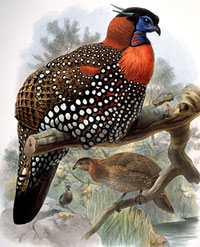Dr. Susan Sharma
Schedule I, Part III of the Indian Wildlife (Protection) Act, 1972 lists rare and endangered birds which are totally protected throughout the country, live or dead or part thereof. They include Andaman Teal, Assam Bamboo Partridge, Bazas, Bengal Florican, Blacknecked
Crane, Blood Pheasants, , Cheer Pheasant, Eastern White Stork, , Jerdon's Courser, Great Indian Bustard, Great Pied Hornbill, Hawks, Hooded Crane, Hornbills, Houbara Bustard, Humes Bartailed Pheasant, Indian Pied Hornbill, Lammergeier, Large Falcons, Large
Whistling Teal, Monal pheasant, Mountain Quail, Narcondam Hornbill, Nicobar Megapode, Nicobar Pigeon, Osprey, Peacock-Pheasant, Peafowl or Indian Peafowl, Pinkheaded Duck, Scalter's Monal Pheasant, Siberian White Crane, Tibetan Snowcock, Tragopan-Pheasant,
Whitebellied Sea Eagle, White-eared Pheasant, White Spoonbill, and Whitewinged Wood Duck.
The Great Himalayan National Park is perhaps the most distinct stronghold of the rare Western Tragopan in India. The most spectacular of pheasants, the Western Tragopan has been reported from all the valleys of the GHNP. This
pheasant is found in high altitude fir-spruce and Deodar forests with Ringal Bamboo (Arundinaria spp.). The maximum number of sightings have been from forests of Basu, Shilt, Nada, Chordwar in Tirthan valley.
 The tragopans or horned pheasants are medium-sized pheasants in which the sexes are highly dimorphic, the males tending toward crimson on the head and sometimes elsewhere, and with extensive white to buffy dorsal spotting.
Males also have two erectile and brightly coloured fleshy horns that are erected during courtship, and a brilliantly coloured gular lappet or bib that can be expanded and exposed during display. The round black-bordered white spots or ocelli on the tragopan's
feathers make it look like the King of Birds studded with diamonds all over. .
The tragopans or horned pheasants are medium-sized pheasants in which the sexes are highly dimorphic, the males tending toward crimson on the head and sometimes elsewhere, and with extensive white to buffy dorsal spotting.
Males also have two erectile and brightly coloured fleshy horns that are erected during courtship, and a brilliantly coloured gular lappet or bib that can be expanded and exposed during display. The round black-bordered white spots or ocelli on the tragopan's
feathers make it look like the King of Birds studded with diamonds all over. .
This species is usually seen singly, in pairs, or small coveys, in fairly dense montane vegetation. The white circular spotting on the greyish upperparts, especially the lower back and upper tail-coverts is distinctive, but the spotting is less regular in females
than in males. Both sexes have reddish faces, and the legs are usually pinkish. During the breeding season the male can be identified by its distinctive call, uttered most often at dusk and daybreak at intervals of about five or ten minutes. It is a far-carrying
waa note, resembling a goose calling or the bleating of a small goat.
In winter the birds are found in the thickest parts of the oak, chestnut, and morenda pine forests having a dense undergrowth of ringal bamboo. But, during the breeding season, they are to be found in the higher parts of the forest,
up to the zone of birches and white rhododendrons, and almost up to the extreme limits of the forest. Roosting by these birds is done in trees, preferentially low evergreens, where there are closely inter-woven leaves and branches, rather than in taller trees.
Great Himalayan National Park is one of only two National Parks in the world to support a population of endangered western tragopan Tragopan malanocephalus. Very limited work has been done on methods for survey and census of these
galliformes. The Parvati Hydel Project has carved out the Great Himalyan National Park destroying the very habitat of these birds. The few that are left are hunted by man for its feathers. The Western Tragopan vanishes for its colourful plumage. Legend tells
that that God created the Tragopan out of feathers shed by every bird in the universe.
Captive breeding for conservation is being attempted at Sarahan in Himachal Pradesh with little success so far.
( Picture Credit: A.O. Hume)